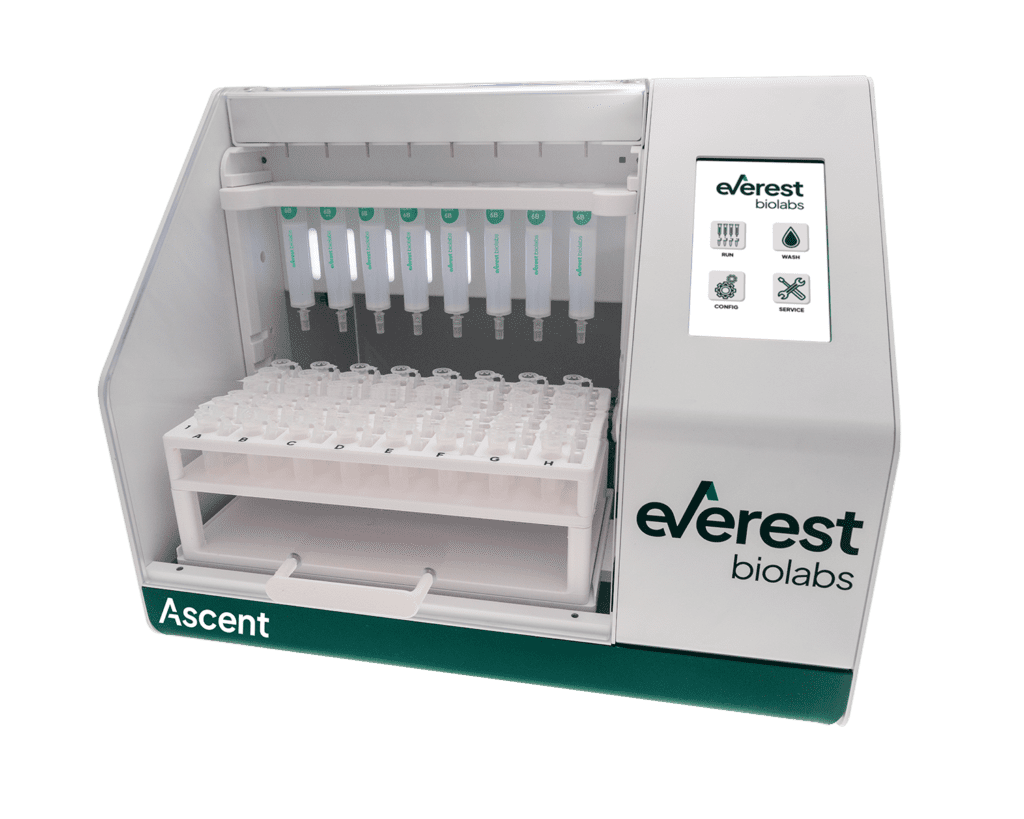Support

FAQs
How long does it take to purify samples on the Ascent?
Running 1 or 8 Apex columns takes about an hour. Since columns are run in parallel, it takes about the same time for any number of columns. First, the columns are washed to remove buffer containing antimicrobial agents. This step takes ~45 minutes. Then the fractions are collected. This takes ~5-15 minutes depending on how many fractions are collected. Apex 4B and 6B columns have the same run time.
Can the Ascent run columns from other suppliers?
Yes. In addition to the Apex columns, the Ascent is compatible with qEVoriginal, qEV1, and qEVsingle columns. If you would like support for additional columns, please contact us.
Can the fraction collection sequence on the Ascent be customized?
Yes. The fraction collection sequence on the Ascent is programmable. The user can adjust the discard volume and the fraction volume according to the input sample volume.
What is Column Saver?
Column Saver automatically keeps columns hydrated. This prevents your columns from drying out if you are not near the instrument when the wash or fraction collection completes. The Column Saver slowly drips buffer into the columns while the Ascent waits for an action from the user (adding samples or removing the columns when it completes).
How does the Ascent accurately collect the correct fraction volume?
Ascent Instrument
The Ascent has a high-precision liquid handling system combined with an advanced optical drop detection platform to precisely collect fractions. This approach is robust to vibrations and can be used on any lab bench.
Apex SEC Columns

Downloads
FAQs
How many times can Apex columns be used?
We have tested columns for up to 5 uses.
What is the repeatability of isolation after regeneration cycles?
Apex columns have a 5% CV in EV yield for up to 5 uses when measured with the Atlas EV ELISA. We know how important repeatability is, so we developed a tightly controlled process for manufacturing columns to ensure the most repeatable columns.
Should I use Apex 6B or Apex 4B?
Apex 6B (SEC columns packed with Sepharose CL-6B resin) are optimized for the highest total EV recovery. These are ideal for targeted downstream analysis, such as immunoassays, label-based imaging assays, label-based flow assays, western blots, and pull-down using a specific surface marker. Apex 4B (SEC columns packed with Sepharose CL-4B resin) are optimized for the highest purity. These are Ideal for unbiased downstream analysis, including proteomics and RNA-seq.
Atlas ELISA Kits

FAQs
How long does it take to run a sample?
The Atlas Human EV ELISA has one 3-hour incubation and one wash step. The total hands-on time is ~15 minutes for plating and washing.
What are the capture and detection antibodies?
The Atlas Human EV ELISA uses antibodies against the tetraspanins CD9, CD63, and CD81. These are used as both capture and detection antibodies.
What is the detection limit of the Atlas Human EV ELISA?
The average LOD is < 1e8 EVs/mL.
Can the Atlas Human EV ELISA be used to quantify EVs directly from biofluids?
Yes. The ELISA has been validated in plasma, serum, urine, cell culture media, and cerebrospinal fluid (CSF). Data for these biofluids is available on the datasheet.
Do you have to use the entire plate at once?
No. The Atlas Human EV ELISA kit has 12 strips of 8 wells. You can run individual strips or the full 96-well plate.
Atlas ELISA Reader

FAQs
What does the reader measure?
The Atlas ELISA reader measures absorbance simultaneously across a 96-well plate.
How long does it take to measure a plate?
It only takes a few seconds to measure an entire 96-well plate.
Can it be used with ELISA kits from other suppliers?
Yes, the reader can be used to read absorbance ELISA kits from other suppliers.